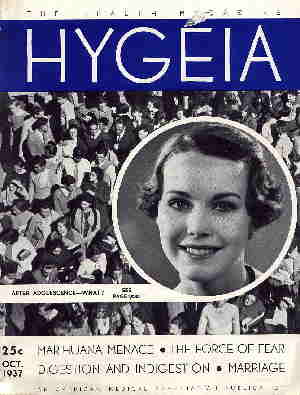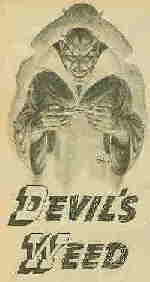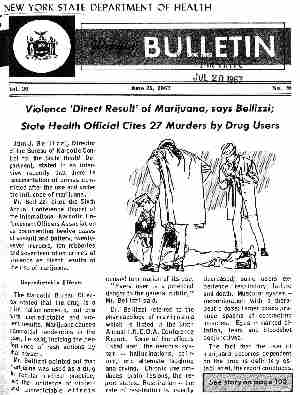
|
 |

|
|---|

MARIHUANA MENACE |
 THE REEFER MADNESS ERA |

Violence Direct result of Marijuana |
|---|
WHY DID THEY DO IT?
(An Editorial Opinion)
With literally thousands of Legal Cannabis Medicines sitting on drug store shelves throughout the country at the time, it's a little hard for Doctors and the Medical Journals to claim that they didn't know any better. In fact (to their great shame), it is almost an impossibility. As Edmund Burke is attributed as saying:
"All that is necessary for the forces of evil to win in this world is for enough good people to do NOTHING."Which brings many today to ask the question: Why did the medical journals do it? WHY did they publish articles that they knew must have been false? And even more important; WHY did they remain silent about what was being said during the Reefer Madness campaign in the first place. Wasn’t it their place to speak out and tell the truth – Just imagine what would have happened had the AMA simply held a press conference and told all those nice reporters that Harry Anslinger’s Reefer Madness campaign was a total lie. “Yep, that’s right folks, it’s all a hoax.”
The answer seems to be very complex and requires an understanding of the cultural and practical considerations of the time. But first some of them did: The Military Surgeon Magazine , in 1933 not only published the "Panama Canal Study" (a medical study favorable to the use of Marihuana), but at later times, a number of editorials on the subject, such as "The Marihuana Bugaboo", etc. Other medical journals such as the "Delaware State Medical Journal" and the "Philadelphia Medicine," also run/re-run editorials favorable on the use of Medical Marihuana. The truth was out there, but it was simply drowned out by the totality of the campaign.
But be that as it may, MOST Medical Journals chose to remain silent and some even joined in on the campaign; Why?
First, it would be helpful to understand that the very early 1930's marked the high point of yet another hysteria campaign. One in which Doctors themselves were portrayed as the villains and thus its victims. This came about as a result of the (1914) Harrison Narcotics Law, which at first only required Doctors to keep track of all their narcotic prescriptions. But soon the law was being used to restrict the sale of opiates, which placed Doctors in quite a bind. Unless they continued to prescribe opiates to their addicted patients (they knew that), they would be sending their otherwise law respecting patient's right into the hands of the criminal underworld.
Thus while many Doctors just stopped writing prescriptions all together; --Obviously many others felt some sympathy and continued the prescriptions. Then the arrests began ; in fact one of the very founders of the AMA itself was jailed on such a charge.
It was within this environment that the new drug czar Harry Anslinger came into power. As he quickly put a stop to (or greatly reduced) these arrests, he must have seemed (to the whole of the medical community) like a God sent from heaven at the time. But one to whom they were indebted to and surely did not want to piss-off. So if the fool (hypothetically) said that either red fire hydrants or medical cannabis was evil, who cared, just humor him. After all, just remember what it was like before he became drug czar.
In the Museum’s opinion, this factor (the fact that Anslinger had Doctors in his hip pocket) played a vital role in the existence of the Reefer Madness campaign, as well as the creation of the anti-Medical Marihuana laws.
Next, while the use of Medical Marihuana is back on the rebound today, with numerous new medical uses seemingly being found daily. In the late 1930's, it was on the downward bent. In the 1880's it’s been estimated that around 6% of all medicines made use of Cannabis (at least) as one of their ingredients. However, by the late 1930’s (excluding corn remedies), this figure was probably no more than 1%. Meaning that it was quickly (during that period of time) becoming a little used drug anyway.
Last of all, one must remember those being arrested for Marihuana smoking at the time ALL had names like Gonzalez or Garcia or LeRoy etc. In other words, "Mexicans" or Negro's" and only in a very few case’s whites (and only those being of the lower classes) being harassed. A factor that most people kind-of-forget now-ah-days.
No wonder so few Medical Journals said anything; WHY ROCK THE BOAT?
– Dec. 1939 - Published by the Kansas Medical Society
The following is present as an example of what was making its way unto print at the time. Please note that it is only one of many such articles that was published in Medical Journals at the time. [Red highlighting added by the Museum for emphases]
PSYCHOSIS FOLLOWING THE USE OF MARIJUANA WITH REPORT OF CASES
– By Howard C. Curtis, M.D. – page 515 Wichita, Kansas
Marijuana also known as (Cannibis indica) and (Indian Hemp) grows in practically every state in the union. In some of the states it grows wild, in others it is cultivated. The plant grown in the United States being identical with the one grown in India, differing only in strength, the one grown in India being the stronger.
The derivatives of this plant at one time were used rather often medicinally, but in recent years it has fallen into disuse and is now seldom if ever used in this country as a medicine. Records show that it has been used extensively by the natives of Egypt and at one time it was credited as causing most of the crime and insanity in that country.
When used medicinally it is an anti-spasmodic, analgesic, anesthetic, and narcotic, a cerebrospinal stimulant and a powerful aphrodisiac. It increases intellectual and motor activity, stimulates the vasomotor nerves, and raises arterial tension. In large doses it causes a peculiar pleasant form of intoxication.
The particular traits of the individual are exaggerated, sexual desire is increased, the sight and hearing is stimulated and exalted. The pupils become dilated and frequently a cataleptic state is induced, and sometimes coma, but no deaths have been reported from an overdose. Repeated use of the drug causes mental confusion, deterioration and personality changes.
While under its influence, the patient is usually expansive, hyperactive, restless and has delusions of grandeur and well being. They seem to lose all sense of space and perception, finally as the drug dies out they become drowsy and stuporous. For the past two or three years its use in this locality has seemed to increase, especially among the adolescent, and high school age. It is used at "parties" and social gatherings to give "kick and pep" to the party, without the user realizing its deleterious effects. Some of the most peculiar and atrocious crimes have been committed by individuals while under the influence of this drug.
I desire to report briefly three private cases that had an unhappy ending:
Case 1. A white male, age thirty, family history negative. His parents were of moderate means and patient attended grade school and finished high school. He made fair grades. I first saw him in 1931, when he was twenty-three years old. He worked at intervals in his father's restaurant, but never steady. He was considered by his parents to be somewhat rowdy, would drink whiskey at times also stay out all night from home, and associate with questionable characters. He also began smoking marijuana and was later arrested and jailed for disturbing the peace. He improved or quieted down while in jail and after a week or so was released. Again in 1932 I was called to see him. His blood and spinal Wassermann tests were negative, he was restless, hyperactive, pupils dilated, he had delusions of grandeur and expansive ideas. We could not keep him at home without restraint, and his family again sent him to jail for the protection of himself and others. I ask for a hearing in lunacy at that time but he again showed some signs of improvement after a few days and no action was taken. He was again set free but after a short time he appeared at the jail again of his own accord and ask to be locked up and treated for his habit but he was not accepted. At that time he was smoking the drug rather freely and rolling his own. He continued his habit and was in and out of trouble, he was married and divorced. Soon his father died and he and his mother moved to Colorado with friends. He secured a job as chauffeur from his friend. In a few months they drove back to Wichita. One night while driving his friend to the country he demanded that his friend sign a bill of sale for the car, also had him sign other papers. He then shot him in the chest, placed him in the back of the car and went to a dance. After the dance he drove to an open well and was going to throw him in but changed his mind and put him back in the car, then drove to the country to a cabin and decided to burn him. He put him in the cabin, set fire to it and burned a part of the building and decided not to burn him. He put him back in the car and drove around Wichita the remainder of the night and in the morning took him to one of our local hospitals and left him, where he died the next day. At that time the patient had in his possession a pistol, whiskey, and marijuana. He was arrested for murder placed in jail and adjudged insane by a commission. He was sent to the Lansing penitentiary and placed in the insane ward. In October, 1938, he was adjudged sane by the prison commission and he was brought back to the Sedgwick County jail awaiting trial for murder.
Case No. 2. A white male age twenty. He gave a history of smoking marijuana for two years, and he took his first cigaret while at a parry, along with friends. After that he took it for the kick or feeling it gave him. He said after he has smoked two or three he felt like he was stepping over the top of the door instead of going through it. He felt great and had no embarrassment. One day while shaving he cut his throat from ear to ear and died within an hour.
Case No. 3. A white male age nineteen, a musician, had smoked marijuana for over a year. He soaked it in alcohol and rolled it himself. When he played in the orchestra for dances the music flowed better after he smoked two or three cigarettes, and he could play fast without any effort and the music seemed to flow without trouble. This patient was killed in an automobile wreck early one morning while returning home from a dance.
It appears from reading the papers of arrests and trials in our courts, that this habit and traffic is rather prevalent. This plant grows wild in Kansas and it has often been found growing along the railroad tracks and waste places. The state of Kansas now has a law prohibiting the cultivation, possession, or sale of marijuana as does practically every other state in the union.
During the year 1935 the Federal Narcotic Bureau seized this illicit product in more than twenty states. Over 14,000 marijuana cigarettes were seized, the largest haul coming from Louisiana. Over ninety per cent in the bulk pounds were seized in New York, six pounds, eight ounces in Kansas. Seizures were also made in eighteen other states.
In April, 1937, a marijuana tax act was introduced to the Seventy-fifth Congress and enacted into law and approved August 2, 1937. This act is closely patterned after the Harrison Narcotic Act and the National Fire arms Act. It is an Internal Revenue Measure, and prohibits the growth and transference unless the producer, importer or dealer is registered with the government.
Conclusions: The effects of marijuana are definitely narcotic in nature.
It is habitually taken for the stimulating effects obtained, and the individuals satisfaction, experienced through the temporary inflation of the personality. No evidence exists that it is cumulative in its effects or that a tolerance may be developed through its continued use. Those who are habitually accustomed to its use frequently develop a delirious rage after its administration during which they are irresponsible and liable to commit violent crimes. Prolonged use will produce mental deterioration, personality changes, and insanity.
Withdrawal symptoms have not been noted as seen in morphine addiction. Marijuana has a worse effect than heroin. It gives the user a lust to kill, unreasonably without motive. Some of the most heinous crimes have been committed by the users of this drug.

|
MUSEUM COMMENTS (Selected Genres) |

|
|---|
WANT TO KNOW MORE:
=====================
Due to space / download time considerations, only selected materials are displayed. If you would like to obtain more information, feel free to contact the museum. All our material is available (at cost) on CD-Rom format.
CONTACT PAGE
|
BACK TO THE MAIN WEBSITE HOME PAGE  THE REEFER MADNESS ERA |
HOME PAGE MAGAZINE |
MAGAZINE COMMENTS (SELECTED GENRES) |
||||
|---|---|---|---|---|---|---|
|
MAGAZINE MAIN INDEX |
1
|
2
|
3
|
4
|
5
|
|
|
SEARCHING INDEX |
6
|
7
|
8
|
9
|
10
|
|